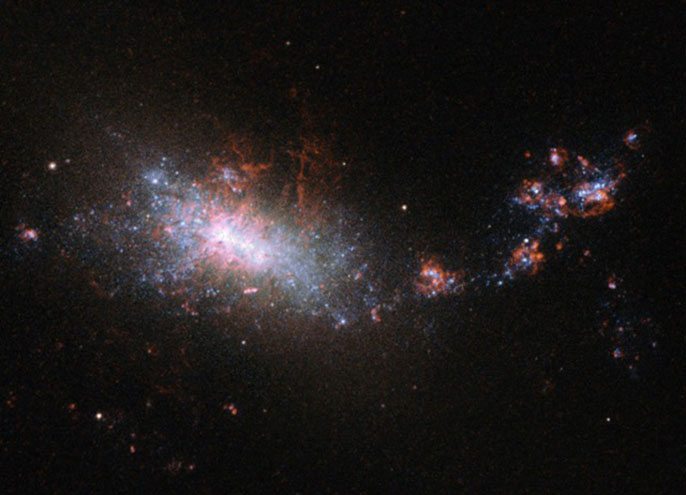One of the main predictions of the current model of the creation of structures in the universe, known at the Lambda Cold Dark Matter model, is that galaxies are embedded in very extended and massive halos of dark matter that are surrounded by many thousands of smaller sub-halos also made from dark matter.
Around large galaxies, such as the Milky Way, these dark matter sub-halos are large enough to host enough gas and dust to form small galaxies on their own, and some of these galactic companions, known as satellite galaxies, can be observed. These satellite galaxies can orbit for billions of years around their host before a potential merger. Mergers cause the central galaxy to add large amount of gas and stars, triggering violent episodes of new star formation −known as starbursts− due to the excess gas brought in by the companion. The host’s shape or morphology can also be disturbed due to the gravitational interaction.
Smaller halos form dwarf galaxies, which at the same time will be orbited by even smaller satellite sub-halos of dark matter which are now far too tiny to have gas or stars in them. These dark satellites therefore are invisible to telescopes, but readily appear in theoretical models run in computer simulations. A direct observation of their interaction with their host galaxies is required to prove their existence.
Laura Sales, an assistant professor at the University of California, Riverside’s Department of Physics and Astronomy, collaborated with Tjitske Starkenburg and Amina Helmi, both of the Kapteyn Astronomical Institute in The Netherlands, to present a novel analysis of computer simulations, based on theoretical models, that study the interaction of a dwarf galaxy with a dark satellite.
The findings were outlined in a just-published paper, “Dark influences II: gas and star formation in minor mergers of dwarf galaxies with dark satellites,” in the journal Astronomy & Astrophysics.
Star formation episodes an last billions of years
The researchers found that during a dark satellite’s closest approach to a dwarf galaxy, through gravity it compresses the gas in the dwarf, triggering significant episodes of starbursts. These star forming episodes may last for several billions of years, depending on the mass, orbit and concentration of the dark satellite.
This scenario predicts that many of the dwarf galaxies that we readily observe today should be forming stars at a higher rate than expected —or should be experiencing a starburst— which is exactly what telescope observations have found.
Furthermore, similarly to mergers between more massive galaxies, the interaction between the dwarf galaxy and the dark satellite triggers morphological disturbances in the dwarf, which can completely change its structure from mainly disk-shaped to a spherical/elliptical system. This mechanism also offers an explanation to the origin of isolated spheroidal dwarf galaxies, a puzzle that has remained unsolved for several decades.
If our reporting has informed or inspired you, please consider making a donation. Every contribution, no matter the size, empowers us to continue delivering accurate, engaging, and trustworthy science and medical news. Independent journalism requires time, effort, and resources—your support ensures we can keep uncovering the stories that matter most to you.
Join us in making knowledge accessible and impactful. Thank you for standing with us!


David Deutsch tells us that high-quality theories are ‘hard to vary.’Cold Dark Matter is a theory that doesn’t meet his standard.
We observe motions we can’t explain with our understanding of gravity and detectable matter (interacting with light). So we hypothesize matter that is does not interact with light in concentrations that fit our observations. No matter what we observe, we add or subtract dark matter so it all works neatly in modeling. It’s a classic example of ‘easy to vary.’ The theory can’t be disproved because it can always be varied to fit new observations. And it makes no predictions that can be tested with future observations. No matter what we see, we can make Cold Dark Matter fit.
That is a problem.
There surely is an explanation for our observations. But if we follow Deutsch’s rule, we won’t give much credence to Cold Dark Matter until the theory is restated to be hard to vary and makes predictions we can test.